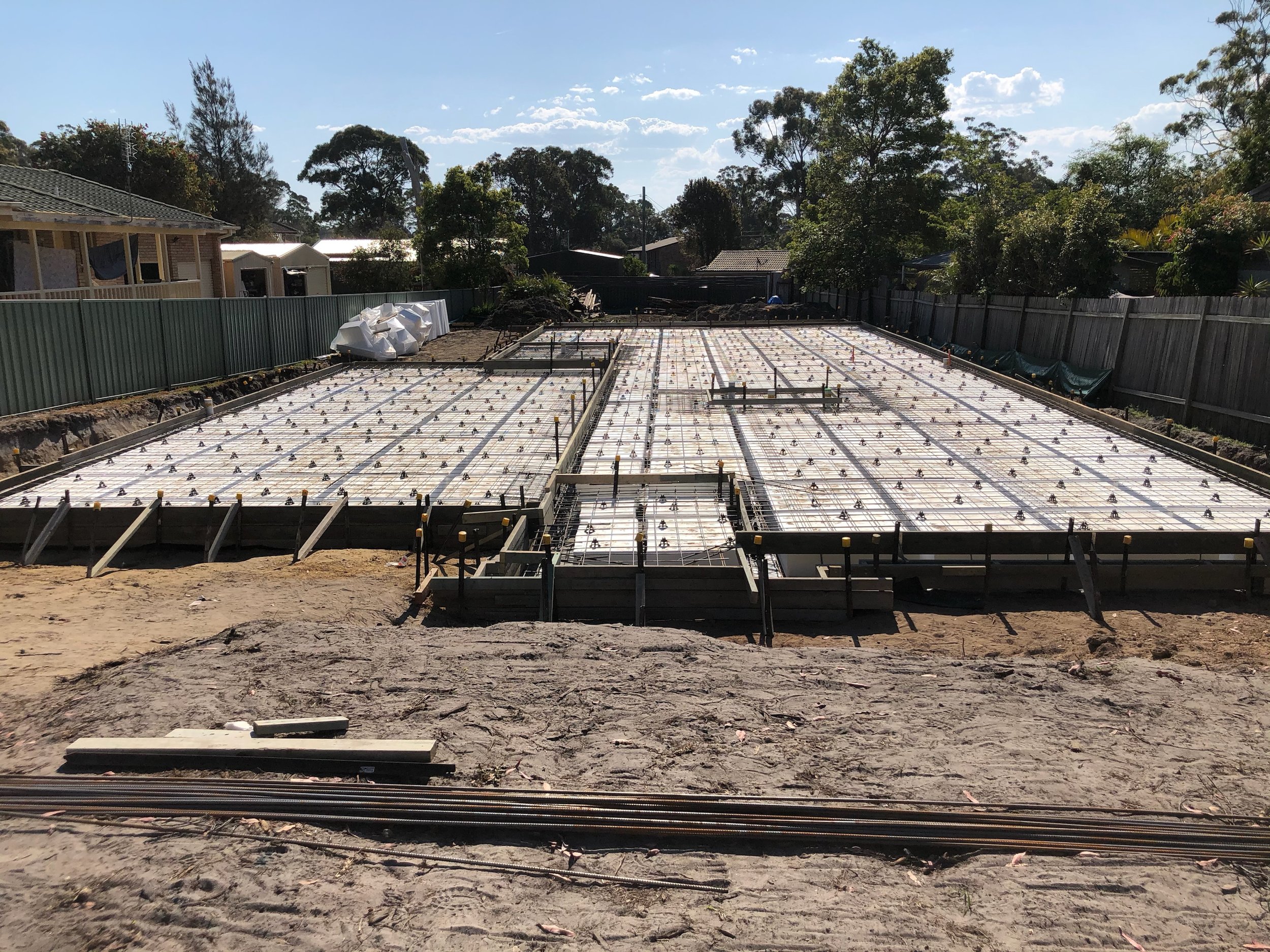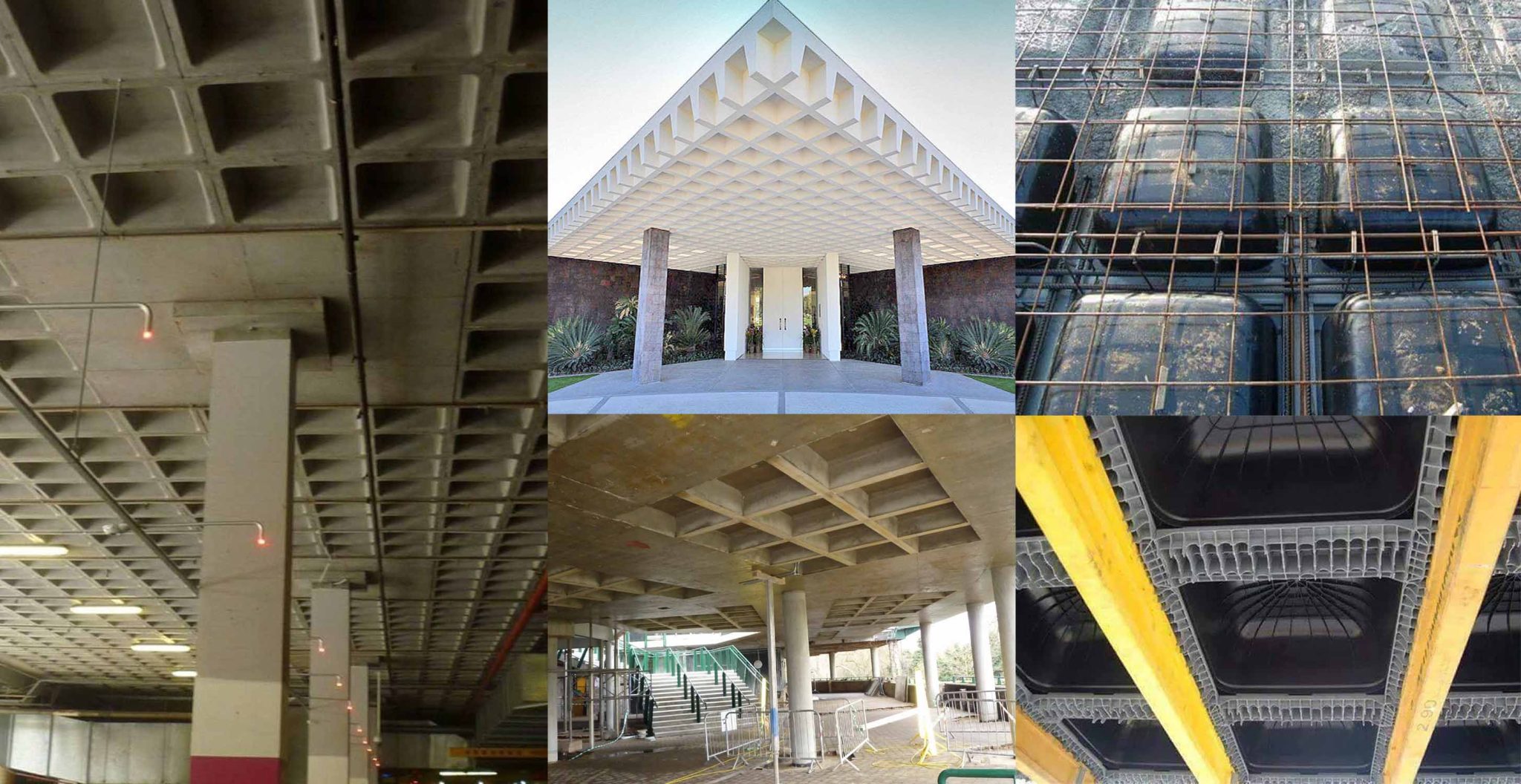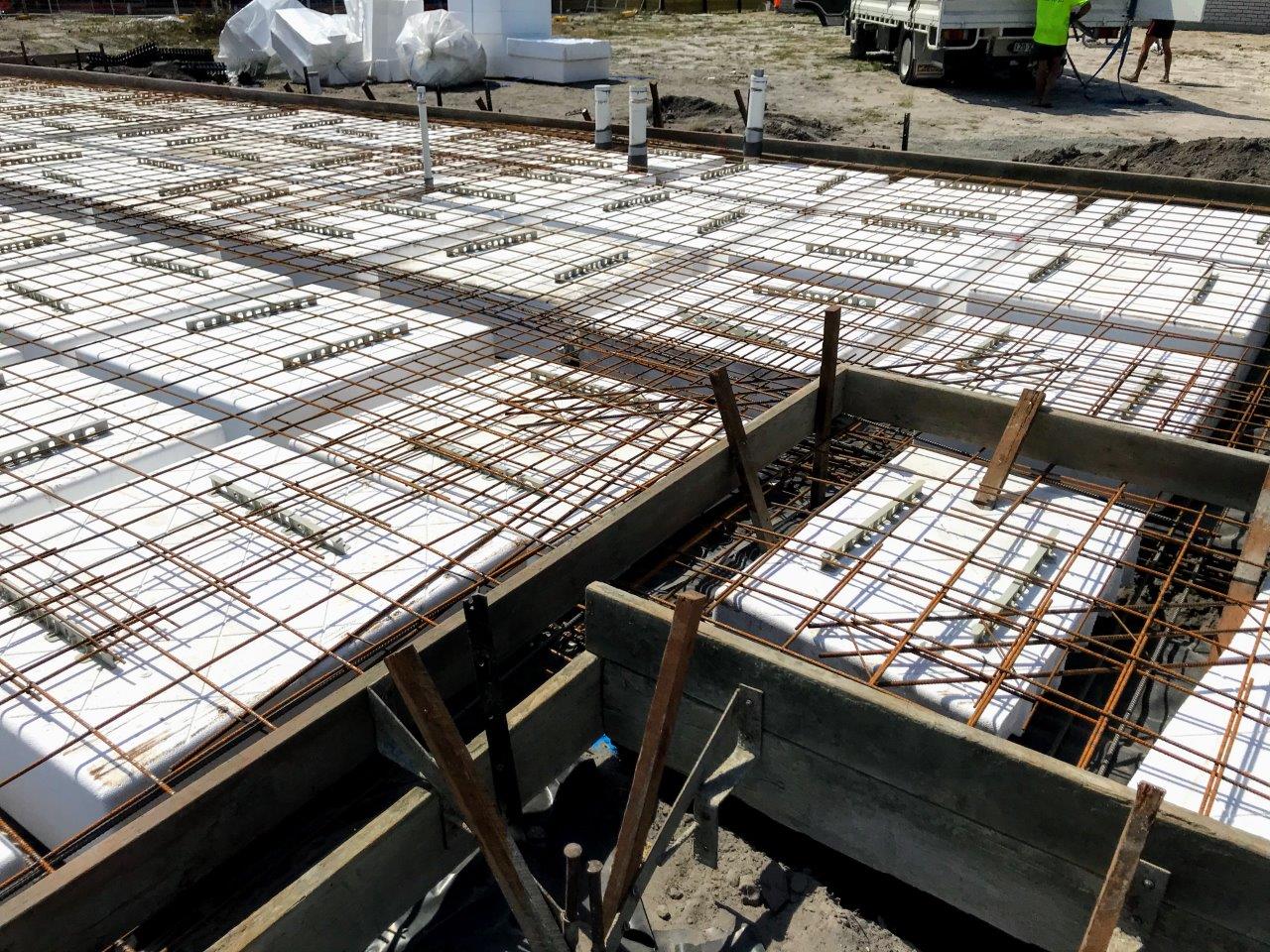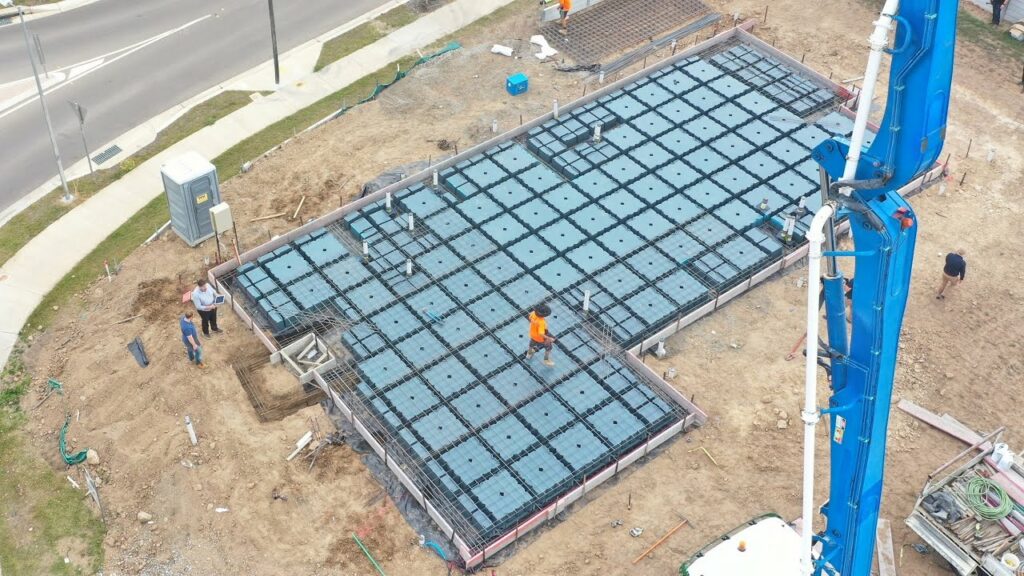Imagine a breakfast waffle with its grid-like pattern. Waffle slabs are reinforced concrete systems comprising a perimeter footing (edge beam) and internal beams (strip footings) at regular intervals. This entire system is built directly on the ground surface, providing a sturdy foundation for construction. A waffle pod slab echoes this design but in the realm of construction. It’s a slab-and-beam system where the beams are cast integrally with the slab. However, the real magic lies beneath the concrete in the hollow spaces created by waffle pods.
These pods are usually made of expanded polystyrene (EPS), a lightweight, insulating material known for its impressive compressive strength. These pods serve as void formers when incorporated into the slab design, reducing the concrete’s weight without compromising its strength. A 2019 study published in the International Journal of Advanced Structural Engineering found that including EPS pods enhanced the slab’s overall structural behavior, making it more responsive to dynamic loads.
Additionally, the recessed design creates a unique “waffle” pattern on the slab’s underside, hence the name. This not only lends structural integrity but also ensures efficient material use, leading to economic benefits in the long run.
The Benefits of Using EPS in Construction
Expanded polystyrene (EPS) stands out due to its myriad advantages:
- Lightweight: EPS has a density ranging from 15 to 30 kg/m³, ensuring easy handling and transportation.
- Thermal Insulation: Its cellular structure provides excellent thermal insulation, with a reported thermal conductivity as low as 0.032 W/mK, according to a survey by Expanded Polystyrene Australia (EPSA).
- Water Resistance: EPS is inherently resistant to water absorption, ensuring longevity in diverse environmental conditions.
Using EPS waffle pods ensures the slab remains lightweight, thermally efficient, and durable, optimizing the balance between form and function. Incorporating waffle pod slabs into a construction project is a nod to futuristic design, environmental consciousness, and economic efficiency. We believe in leveraging such innovations to achieve structural excellence.
Learn More: Structural Engineer in Newcastle

Waffle Slab Construction: Efficiency Redefined
The Blueprint of Waffle Slab Design
At the heart of the waffle slab system lies a meticulous design strategy. It begins with a comprehensive understanding of the site’s soil conditions, load requirements, and the structure’s purpose. With these inputs, the appropriate grid size for the waffle can be determined, optimizing both structural integrity and resource utilization.
The grid design is crucial. According to a 2018 Journal of Structural Engineering and Construction study, tighter grid spacing can lead to better load distribution, while a more expansive grid can be advantageous for thermal insulation. Balance is key.
The Anatomy of Waffle Slab Construction
- Site Preparation: The first step involves leveling the construction site, ensuring even weight distribution.
- Placement of Waffle Pods: The EPS waffle pods are strategically placed based on the design grid. These serve as molds for the concrete pour and will form the voids in the slab.
- Reinforcement Integration: Steel reinforcements are intertwined within the pods, ensuring the slab can withstand dynamic loads.
- Concrete Pour: High-quality concrete is poured over the grid, embedding the pods and reinforcements. Once cured, a robust waffle slab is ready to bear loads and stand the test of time.
- Post-Construction Checks: After the concrete has been set, engineers conduct tests to ensure the slab meets all structural standards. This includes assessing its load-bearing capacity, deflection rates, and overall structural integrity.
Why Choose Waffle Slab Construction?
Beyond the innovative design, there are tangible benefits to adopting waffle slab construction:
- Reduced Groundwork: Due to the inherent design, there’s a significant reduction in soil excavation, which speeds up the construction process and minimizes environmental disruptions.
- Resource Efficiency: The use of EPS waffle pods implies less concrete usage. An Australian Institute of Buildings analysis suggests potential concrete savings of up to 30% in specific projects.
- Load Distribution: The grid design ensures an even distribution of loads, reducing the risk of cracks and structural issues.
Waffle slab construction offers a harmonious blend of science, engineering, and efficiency. As we constantly emphasize, it’s not just about building structures; it’s about building the future.
Read More: Structural Engineer in Melbourne
The Structural Dynamics of Waffle Pod Slabs
Concrete, Compression, and Waffle Pods
Concrete slabs are predominantly subjected to compressive loads by their inherent nature. When we think about a building’s weight or the furnishings within, compressive forces act downwards. The waffle pod slab design uses Expanded Polystyrene (EPS) pods to create voids, ensuring the concrete is effectively used where it’s most needed: in the ribs or beams.

Load Transfer and Distribution
The efficiency of any slab design lies in its ability to distribute loads effectively. The interconnected rib system of a waffle slab does precisely this. When a load is applied, it’s dispersed through the ribs, ensuring even distribution and minimizing point loads. This ensures that the slab can handle higher loads without significant deformation.
According to a research paper from the Institute of Structural Engineers, the waffle design shows an approximate 20% increase in load distribution efficiency compared to traditional flat slabs.
Thermal Dynamics and Insulation
We’ve touched upon the insulative properties of EPS, but let’s delve deeper. The thermal resistance of a material, often denoted as its R-value, is crucial in construction. Higher R-values mean better-insulating properties. EPS, especially in the thicknesses used for waffle pods, has an impressive R-value. This translates to structures requiring less heating and cooling energy, effectively contributing to their green ratings.
Reinforcement: The Backbone of the Slab
Steel reinforcements within the slab provide the tensile strength to complement the concrete’s compressive strength. These reinforcements are meticulously placed in the ribs in waffle slabs, ensuring maximum structural integrity. The reinforcement mesh’s size, type, and spacing are determined based on load requirements, slab dimensions, and other project-specific factors.
Finite Element Analysis (FEA) and Waffle Slabs
Modern structural engineers employ advanced tools like Finite Element Analysis (FEA) to predict how a waffle slab will behave under various conditions. This computer-based method divides the slab into thousands (or even millions) of elements and expects how each will behave under load. This ensures the design is optimized for strength, efficiency, and longevity.
Waffle Pods for Concrete Slabs: An Insightful Perspective
The Evolution of Construction Techniques
Throughout history, the construction industry has sought ways to optimize resources while delivering uncompromised structural integrity. Enter waffle pods: a testament to this commitment. These game-changers have transformed conventional slab designs, providing enhanced benefits with every square meter.
Decoding the Utility of Waffle Pods
The key to understanding the appeal of these pods is to delve into their distinct attributes:
- Material Excellence: Expanded Polystyrene (EPS) forms the backbone of waffle pods. Its unmatched compressive strength means it can support heavy concrete without deforming, ensuring the structural soundness of the slab.
- Adaptability: They can be employed in various configurations, catering to different architectural demands and geological settings.
- Environmental Merit: A notable highlight is the eco-friendly nature of EPS. According to the Sustainable Building Solutions Report 2020, EPS boasts recyclability, contributing to reduced landfill waste. This sustainable choice aligns with global movements pushing for greener construction methods.
Economic and Functional Benefits
It’s not just about the environmental footprint or structural integrity. The functionality waffle pods bring to the table is unparalleled:
- Thermal Efficiency: Their inherent insulating properties lead to energy conservation, directly translating to cost savings in climatic control. Research from the Australian Energy Council suggests buildings using waffle slabs can realize energy savings of up to 15%.
- Cost-effectiveness: By reducing the volume of concrete required, there are direct savings on material costs. Furthermore, the reduced weight of the slab can lead to savings in foundational expenses, as lighter slabs require less intensive foundation systems.
- Durability: The integration of waffle pods enhances the lifespan of the slab. Providing voids makes the concrete less dense, reducing the risks of cracking and stress-related damage.
We aim to leverage the best engineering techniques to ensure our clients’ projects stand tall, literally and metaphorically.
Checkout: Structural Engineer in Parramatta
Addressing the Elephant in the Room: Waffle Pod Slab Failure
Perceptions and Realities
In the realm of structural engineering, no innovation goes without scrutiny. Despite its myriad advantages, the waffle pod slab has been under the scanner due to instances of reported failures. However, it’s pivotal to discern between inherent design flaws and execution errors.
Common Causes of Waffle Slab Failures
To make informed decisions, one must be aware of the potential pitfalls:
- Inadequate Site Assessment: A crucial determinant of the slab’s performance is the ground on which it rests. A study by the Australian Geomechanics Society highlights the importance of thorough soil tests. Slabs on expansive or reactive soils without proper precautions can encounter differential settlement issues.
- Improper Pod Placement: The placement of waffle pods must follow the specified grid design meticulously. Deviations can lead to uneven load distribution, compromising the slab’s structural integrity.
- Insufficient Reinforcement: Steel reinforcements must be appropriately placed and embedded within the concrete, integral to the slab’s strength. A lapse here can significantly reduce the slab’s load-bearing capacity.
- Subpar Concrete Quality: The concrete’s composition and curing process directly impacts the slab’s durability. Fast-tracked curing or inadequate water ratios can result in premature cracks.

Mitigating Risks: The Path Forward
Understanding potential challenges allows for proactive solutions:
- Expert Consultation: Engaging with seasoned structural engineers ensures that all aspects, from soil assessment to concrete pouring, adhere to best practices.
- Quality Assurance: Regular checks at various construction stages can identify and rectify deviations before they escalate into significant concerns.
- Educating Stakeholders: A well-informed construction team, aware of the intricacies of waffle slab construction, can significantly reduce errors.
It’s paramount to remember that with proper design, execution, and oversight, the waffle pod slab system is reliable and superior to many conventional methods. We pride ourselves on precision, ensuring that every waffle slab we consult stands robust against challenges.
Are Waffle Pod Slabs Banned in Australia? Clearing the Air
The Origins of the Debate
Australia’s diverse geographical landscape means varied soil types and conditions, each with unique challenges. In recent years, there’s been increasing discourse around the suitability of waffle pod slabs, particularly in regions with highly reactive soils.
Current Regulatory Stance
Firstly, to address the burning question: Are waffle pod slabs banned in Australia? The unequivocal answer is no. Australian construction standards, governed by the Building Code of Australia (BCA) and local council regulations, have no blanket ban on these slabs.
However, there are zones where additional precautions or design alterations might be required, primarily due to soil reactivity or potential for ground movement. For instance, areas prone to drought and subsequent heavy rainfall can cause significant soil movement, which needs to be considered in the design phase.
Adherence to Standards: The Cornerstone of Safe Construction
The key to successfully implementing waffle pod slabs in Australia, or anywhere for that matter, is rigorous adherence to standards:
- AS2870-2011: This Australian Standard provides a classification of residential site soils and details the design and construction of slabs. Following this guideline ensures slabs are designed for the specific site conditions.
- Quality Control: Only high-grade EPS should be used for the pods. Subpar quality can lead to deformation under the weight of the concrete, leading to structural vulnerabilities.
- Regular Inspections: Periodic checks, especially in the initial years after construction, can identify potential issues early on.
Our Commitment
We understand the concerns and the stakes. Ensuring safety, longevity, and compliance is not just a professional commitment but a moral one. We prioritize up-to-date knowledge, ensuring our projects align with the latest regulations and best practices. Every slab associated with us is a testament to quality, safety, and engineering excellence.
Conclusion: The Path Forward with Waffle Pod Slabs
Embracing the Future of Construction
As the architectural landscape evolves, so do the techniques and materials that underpin it. The rise of the waffle pod slab represents an advancement in construction methodology and a paradigm shift in how we perceive sustainability, efficiency, and design in structural engineering.
Balancing Innovation and Tradition
While harnessing the power of innovative techniques like the waffle pod slab system is essential, it’s equally crucial to anchor them in time-tested structural engineering principles. This balance ensures that while we push the boundaries of what’s possible, we never compromise on safety or integrity.
According to the Council of Tall Buildings and Urban Habitat (CTBUH), integrating innovative designs with traditional knowledge can lead to structures that are not only more resilient but also more adaptable to changing environmental conditions.
The Road Ahead: Challenges and Opportunities
Like any other construction method, waffle pod slabs will continue to face challenges, from evolving regulations, changing soil dynamics, or new findings in structural engineering. However, these challenges also represent opportunities:
- Research and Development: Continuous research will undoubtedly lead to even more refined versions of waffle slabs, enhancing their efficiency and adaptability.
- Collaborative Endeavors: Partnerships between structural engineers, architects, and environmentalists can lead to holistic solutions addressing functional and ecological concerns.
- Empowering Stakeholders: By educating professionals in the construction industry and the public about the nuances of waffle pod slabs, we can foster trust and drive widespread adoption.
Charting the Future with Us
Our journey with waffle pod slabs is fueled by a vision: redefining tomorrow’s skylines while staying rooted in the bedrock of engineering excellence. As we look towards the future, we invite you to participate in this transformative journey. Because, with the right partners, the future isn’t just built; it’s sculpted with precision, passion, and promise.
Innovation waits for no one. If you’re poised to make a mark with your next construction venture, ensure it stands on the robust foundation of these waffle slabs. Engage with our seasoned team at Structural Consultancy and elevate your vision to unmatched heights.





